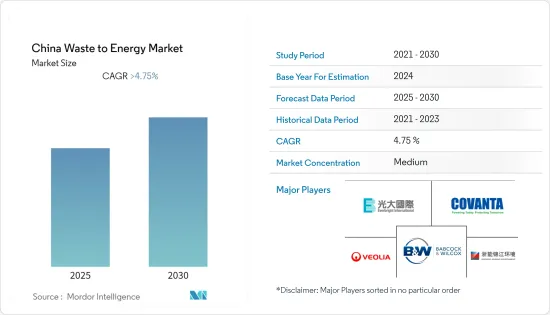Need help finding what you are looking for?
Contact Us
PUBLISHER: Mordor Intelligence | PRODUCT CODE: 1627110

PUBLISHER: Mordor Intelligence | PRODUCT CODE: 1627110
China Waste to Energy - Market Share Analysis, Industry Trends & Statistics, Growth Forecasts (2025 - 2030)
PUBLISHED:
PAGES: 90 Pages
DELIVERY TIME: 2-3 business days
SELECT AN OPTION
The China Waste to Energy Market is expected to register a CAGR of greater than 4.75% during the forecast period.

Key Highlights
- Over the long term, favorable government policies and increasing investments in the country are expected to drive the market.
- On the other hand, the emission of harmful gases generated from waste-to-energy plants and the ash produced from these plants, which needs to be disposed of safely, usually in landfills, leading to groundwater contamination, may also hinder the growth of the market.
- However, the daily per capita waste generation in the region is expected to increase by nearly 40% by 2050. Thus, the increasing volume of municipal waste and rising demand for energy in the region are expected to create an opportunity for the waste-to-energy market in China in the future.
China Waste to Energy Market Trends
Thermal-based Waste-to-Energy Conversion to Dominate the Market
- In 2019, China became one of the prominent countries that installed the world's largest incineration plant (the Shenzhen East waste-to-energy plant). The plant can process 2.7 million ton of waste per year and generate 1.5 billion kilowatt-hours of power per year.
- Plants that utilize cogeneration of thermal power (heating and cooling), along with electricity generation, are estimated to reach optimum efficiencies of 80%.
- Presently, incineration is the most well-known waste-to-energy technology for municipal solid waste (MSW) processing.
- However, waste-to-energy technologies, particularly incineration, produce pollution and carry potential health safety risks.
- To reduce particulate and gas-phase emissions, incineration plant owners have adopted a series of process units for cleaning the flue gas stream, leading to a significant improvement in terms of environmental sustainability.
Increasing Investments to Drive the Market
- China is the second-largest producer of municipal waste in the world. Therefore, it initiated waste sorting plans in 2017 and aims to build 100 zero-waste cities by 2025.
- The country's disposed waste increased from 158 million ton in 2010 to 248.7 million ton in 2021, an increase of around 57.4%.
- Under Chinese President Xi Jinping's plan to tackle pollution, the incineration industry is expected to continue its expansion and replace stinky, polluting, land-intensive garbage dumps. With its massive population producing vast quantities of garbage (increasing by 8-10% annually), China is looking for new facilities that burn solid waste to produce electricity.
- By 2025, China's solid waste generation is expected to double to more than 500 million metric ton annually. This factor is further expected to create a huge demand for waste treatment facilities in the country during the forecast period.
- Such factors are expected to drive the market for waste to energy in China during the forecast period.
China Waste to Energy Industry Overview
China's waste-to-energy market is moderately fragmented. Some of the key players are (in no particular order) China Everbright International Limited, Zheneng Jinjiang Environment Holding Co. Ltd, Babcock & Wilcox Enterprises Inc., Covanta Holding Corporation, and Veolia Environnement SA.
Additional Benefits:
- The market estimate (ME) sheet in Excel format
- 3 months of analyst support
Product Code: 49282
TABLE OF CONTENTS
1 INTRODUCTION
- 1.1 Scope of the Study
- 1.2 Market Definition
- 1.3 Study Assumptions
2 RESEARCH METHODOLOGY
3 EXECUTIVE SUMMARY
4 MARKET OVERVIEW
- 4.1 Introduction
- 4.2 Market Size and Demand Forecast in USD billion, till 2027
- 4.3 Recent Trends and Developments
- 4.4 Government Policies and Regulations
- 4.5 Market Dynamics
- 4.5.1 Drivers
- 4.5.2 Restraints
- 4.6 Supply Chain Analysis
- 4.7 PESTLE Analysis
5 MARKET SEGMENTATION BY TECHNOLOGY
- 5.1 Physical
- 5.2 Thermal
- 5.3 Biological
6 COMPETITIVE LANDSCAPE
- 6.1 Mergers and Acquisitions, Joint Ventures, Collaborations, and Agreements
- 6.2 Strategies Adopted by Leading Players
- 6.3 Company Profiles
- 6.3.1 China Everbright International Limited
- 6.3.2 Zheneng Jinjiang Environment Holding Co. Ltd
- 6.3.3 Babcock & Wilcox Enterprises Inc.
- 6.3.4 Covanta Holding Corporation
- 6.3.5 Veolia Environnement SA
7 MARKET OPPORTUNITIES AND FUTURE TRENDS
Have a question?


SELECT AN OPTION
Have a question?


Questions? Please give us a call or visit the contact form.
